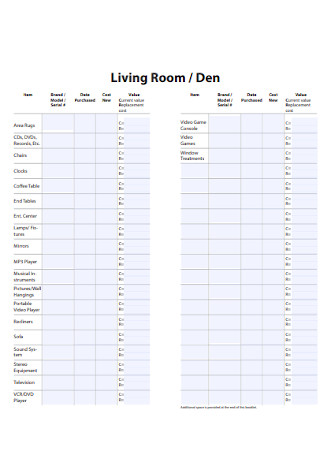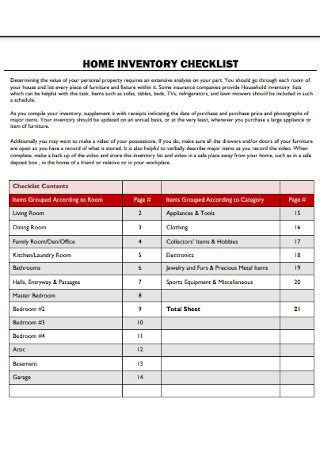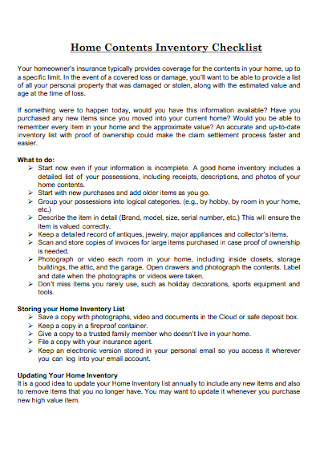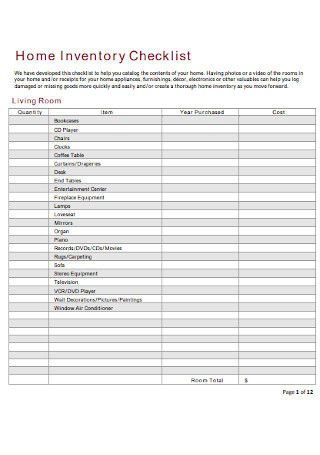24+ Sample Home Inventory Checklists
-

Farm Home Inventory Checklist
download now -

Home Inventory Insurance Checklist
download now -

Personal Property Home Inventory Checklist
download now -

Home Room Inventory Checklist
download now -

Sample Home Iinventory Checklist
download now -

Home Inventory Checklist Format
download now -

Bedroom Inventory Checkliist Template
download now -

Simple Home Inventory Checklist
download now -

Home Property Inventory Checklist
download now -

Home Owners Inventory Checklist
download now -

Basic Home Inventory Checklist
download now -

Home Inventory Checklist Example
download now -

Home Family Inventory Checklist
download now -

Home Storage Inventory Checklist
download now -

Home Living Room Inventory Checklist
download now -

Formal home Inventory Checklist
download now -

Home Contents Inventory Checklist
download now -

Home Broker Inventory Checklist
download now -

Home Mortgage Inventory Checklist
download now -

Moving Home Inventory Checklist
download now -

Homeowner Claim Inventory Checklist
download now -

Personal Home Inventory Checklist
download now -

Home Outdoor Inventory Checklist
download now -

Inventory Checklist for Home Trunk
download now -

Printable Home Inventory Checklist
download now
FREE Home Inventory Checklist s to Download
24+ Sample Home Inventory Checklists
What is a Home Inventory Checklist?
Benefits of Home Inventory Checklists
When to Create a Home Inventory Checklist
How to Create a Home Inventory Checklist
FAQs
What should be included in a home inventory list?
Is a home inventory a list?
Why should I inventory my home?
How much does a home inventory cost?
What is a Home Inventory Checklist?
A home inventory checklist is an itemized list of all of your belongings at home. Depending on your preference, this list can be categorized in several ways such as per room, type of item, collection, or other relevant criteria that make sense to you.
Homeowners and renters are strongly advised to create a home inventory checklist to have an accurate account of their possessions at home. This list of possessions in your checklist will make it easier for them to file for insurance claims in the event of loss, damage, or theft of your belongings.
Aside from homeowners or renters’ insurance claims, a home inventory template can also be used when moving from one house into a new home. Although there is an altogether different movers’ inventory sheet, your own household inventory list for moving will ensure that all of your properties, furniture, food, and other general household items are accounted for—including their condition and estimated value.
As much as possible your home inventory checklist should be up-to-date and catalogs your possessions including item descriptions (make, model and serial number if applicable), value, and purchase date. A video or photograph of each item is also a good way to supplement your written list and a visual record of your belongings that you have in your house and undeniable proof of ownership. Aside from photos and videos of the items, it is also highly encouraged to keep sales receipts of your items.
Benefits of Home Inventory Checklists
The main reason for having a home inventory checklist is to ensure that you will be able to prove the loss or damage to your property and get the maximum amount from your insurance company should you want to make a claim. Without this, your insurance company will most likely skimp or not pay you at all with your insurance claims. This means that all those insurance premiums you’ve been paying were all for naught. Below are some other benefits of having a home inventory checklist.
Purchase of Right Amount of Insurance
An accurate list of all of your possessions will earn you a more productive conversation with your insurance company regarding your insurance coverage. Knowing the items that you have will allow you to insure them adequately and purchase the right amount and type of insurance that you need.
Proof of Ownership
The threat of loss of property because of fire, theft, and other causes will always be present and a home inventory checklist can be used as proof of ownership. Including photos and videos of your property and items in your home inventory checklist can make your claim irrevocable and provide you with additional irrefutable proof of ownership of lost or damaged items.
Expedite Home Insurance Claims
It’s important that your home inventory checklist contains as many details as possible. If anything were to happen in your home, like in case of fire and other disasters, you will be able to provide your insurance company a detailed inventory of your home and personal belongings that you lost. Although the processing of your claims will take some time, your home inventory checklist will help expedite your claims by eliminating the back and forth just to prove ownership of your own properties.
Substantiate financial losses for tax purposes or when applying for financial assistance
After experiencing a major disaster or catastrophe, the next thing you want is to experience a break from life’s lemons thrown your way. If you have an Excel spreadsheet of your home inventory, you will be able to easily determine whether you qualify for a tax break or apply for disaster assistance to help you recover and substantiate your financial losses. Inventory worksheets and other printable home inventory checklists are useful tools in this process especially if they are well-organized and have detailed contents in them.
When to Create a Home Inventory Checklist
If you don’t have an inventory checklist yet, it’s high time that you make one now. True, it’s a tedious task, but it can really help you in the long run and time well spent. Better to create one now in preparation for all other unprecedented and unexpected situations. You will need a home inventory checklist for:
How to Create a Home Inventory Checklist
Putting together a home inventory checklist is essential especially when you’re packing your belongings before moving or simply organizing your home. The process of creating one is pretty straightforward to do. Just follow these simple steps for when you’re making your own home inventory checklist.
Step 1: Decide a Structure for Your List
To help you get started with your home inventory list, get a pen and a piece of paper or open a blank document on your computer. Make a template of your inventory list by creating three columned tables in your sheet. Enter a header for each column: item name and brand for column one, condition of the item on the second column, and the estimated value of the item on the third. It’s optional but you may also include the year the items were purchased. This structure should be replicated in each room of your house.
Step 2: List All Items in Each Room
Once you have structured your list, go in room by room and list down all items that you see in it. Even if you’re unsure if it will be covered by your insurance or you will bring it with you when you move, don’t skip it. It’s important to be detailed. If you have a bookshelf, include it on your list as well as all items on the shelf. Highlight books that are valuable to collectors, framed photos, and whatnots. Note the condition of each item and write down the estimated value. Repeat this step in every room that you have in your home. Remember, the more detailed inventory, the more useful it will be if you have to make a claim or for when you move.
Step 3: Store Your Home Inventory Checklist in a Safe Place
After you have written down your home inventory, keep it in a dry and safe place, preferably off-site. You may also keep a digital format of your checklist will help ensure that you don’t lose it and you have a backup for it. You may also include a visual recording such as photos or videos of your properties and upload it to a cloud-based server. Digital copies of your inventory are also easy to update in the long run.
Step 4: Don’t Forget Your Other Assets
While this is a home inventory checklist, the concept of it is also applicable in making an inventory of your business and other assets, especially when they are within your home property. It’s crucial that you also document the contents of your business if it’s applicable. A separate insurance claim about your business can be filed and claimed in the event of disasters, damages, or loss.
Step 5: Regularly Update Your Home Inventory Checklist
Whenever you purchase new items for your home, especially big-ticket items, never forget to update your inventory checklist. Add the information of these significant purchases while its details are still fresh in your memory. It’s also a good idea to remove or delete items on your list if you have already replaced or no longer own them.
Aside from new purchases, always consider your valuable items like pieces of jewelry or art collections. If you can have them appraised, the better. Valuable items tend to increase their value over time and updating their estimated price will ensure that you have adequate insurance coverage for them. You should also store your collectibles in places in a safe deposit box.
FAQs
What should be included in a home inventory list?
As much as possible, include all items that you have in your home on your home inventory checklist. It would also be helpful if you provide photos and videos of your items. Aside from that, information that you need to include in the description of the items, make, model, and serial number as well as receipt or approximate value of each item, and date of purchase.
Is a home inventory a list?
Yes, it is a list of all items that you own and have in your home.
Why should I inventory my home?
Having a home inventory can prove to be invaluable if you lost your belongings to theft, fire, floods, and other natural disasters. The list of all your personal belongings will be used for various processes like filing for insurance claims, disaster assistance, or for the full police report.
How much does a home inventory cost?
There is no value attached to creating a home inventory. However, you will need to invest your time and resources into making one. Although there are inventory services available, it is better if you do the inventory of your home on your own instead of having someone else do it for you. You know your belongings better and it will ensure that everything you own is accounted for.
A home inventory checklist is an essential document to have when you want to maintain and organize your home, take out insurance for your belongings, or create a list when you move out. It is an easy way to verify all of the items that you own during loss, damages, and moving. It’s also very handy when you need to file homeowners or renters insurance claims. When you really think about it, a home inventory is an extra layer of security to protect your hard-earned material possessions. If you’re still unsure how or where to start when it comes to home inventory, browse through a selection of samples on our website.
